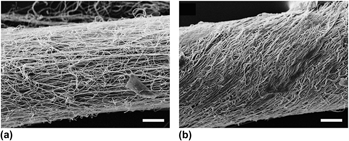Crossref Citations
This article has been cited by the following publications. This list is generated based on data provided by
Crossref.
Sui, Xiaomeng
Wiesel, Erica
and
Wagner, H. Daniel
2012.
Mechanical properties of electrospun PMMA micro-yarns: Effects of NaCl mediation and yarn twist.
Polymer,
Vol. 53,
Issue. 22,
p.
5037.
Chen, Kun
Zhang, Shichao
Liu, Bowen
Mao, Xue
Sun, Gang
Yu, Jianyong
Al-Deyab, Salem S.
and
Ding, Bin
2014.
Large-scale fabrication of highly aligned poly(m-phenylene isophthalamide) nanofibers with robust mechanical strength.
RSC Adv.,
Vol. 4,
Issue. 86,
p.
45760.
Niu, Haitao
Gao, Weimin
Lin, Tong
Wang, Xungai
and
Kong, Lingxue
2014.
Composite yarns fabricated from continuous needleless electrospun nanofibers.
Polymer Engineering & Science,
Vol. 54,
Issue. 7,
p.
1495.
Shao, Hao
Fang, Jian
Wang, Hongxia
Lang, Chenhong
and
Lin, Tong
2015.
Robust Mechanical-to-Electrical Energy Conversion from Short-Distance Electrospun Poly(vinylidene fluoride) Fiber Webs.
ACS Applied Materials & Interfaces,
Vol. 7,
Issue. 40,
p.
22551.
Tian, Long
Zhao, Chuchu
Li, Jie
and
Pan, Zhijuan
2015.
Multi-needle, electrospun, nanofiber filaments: effects of the needle arrangement on the nanofiber alignment degree and electrostatic field distribution.
Textile Research Journal,
Vol. 85,
Issue. 6,
p.
621.
Selle, Hila Klein
Bar-On, Benny
Marom, Gad
and
Daniel Wagner, H.
2015.
Gelatin yarns inspired by tendons — Structural and mechanical perspectives.
Materials Science and Engineering: C,
Vol. 47,
Issue. ,
p.
1.
Tian, Long
Yan, Tao
and
Pan, Zhijuan
2015.
Fabrication of continuous electrospun nanofiber yarns with direct 3D processability by plying and twisting.
Journal of Materials Science,
Vol. 50,
Issue. 21,
p.
7137.
Joseph, John
Nair, Shantikumar V.
and
Menon, Deepthy
2015.
Integrating Substrateless Electrospinning with Textile Technology for Creating Biodegradable Three-Dimensional Structures.
Nano Letters,
Vol. 15,
Issue. 8,
p.
5420.
Shuakat, Muhammad Nadeem
and
Lin, Tong
2016.
Direct electrospinning of nanofibre yarns using a rotating ring collector.
The Journal of The Textile Institute,
Vol. 107,
Issue. 6,
p.
791.
Mokhtari, F.
Salehi, M.
Zamani, F.
Hajiani, F.
Zeighami, F.
and
Latifi, M.
2016.
Advances in electrospinning: The production and application of nanofibres and nanofibrous structures.
Textile Progress,
Vol. 48,
Issue. 3,
p.
119.
Rogalski, James J.
Bastiaansen, Cees W. M.
and
Peijs, Ton
2017.
Rotary jet spinning review – a potential high yield future for polymer nanofibers.
Nanocomposites,
Vol. 3,
Issue. 4,
p.
97.
Maleki, H.
Gharehaghaji, A.A.
and
Dijkstra, P.J.
2017.
Electrospinning of continuous poly (L-lactide) yarns: Effect of twist on the morphology, thermal properties and mechanical behavior.
Journal of the Mechanical Behavior of Biomedical Materials,
Vol. 71,
Issue. ,
p.
231.
Amini, Golchehr
Banitaba, Seyedeh Nooshin
and
Gharehaghaji, Ali Akbar
2017.
Imparting strength into nanofiberous yarn by adhesive bonding.
International Journal of Adhesion and Adhesives,
Vol. 75,
Issue. ,
p.
96.
Gu, Xianyuan
Li, Ni
Luo, Jingjing
Xia, Xin
Gu, Haihong
and
Xiong, Jie
2018.
Electrospun polyurethane microporous membranes for waterproof and breathable application: the effects of solvent properties on membrane performance.
Polymer Bulletin,
Vol. 75,
Issue. 8,
p.
3539.
Maleki, Homa
and
Barani, Hossein
2018.
Morphological and mechanical properties of drawn poly(l‐lactide) electrospun twisted yarns.
Polymer Engineering & Science,
Vol. 58,
Issue. 7,
p.
1091.
Abhari, Roxanna Elizabeth
Carr, Andrew Jonathan
and
Mouthuy, Pierre-Alexis
2018.
Electrofluidodynamic Technologies (EFDTs) for Biomaterials and Medical Devices.
p.
295.
Kanygin, Mikhail
Li, Yanyi
and
Bahreyni, Behraad
2019.
Electrospun Coaxial Nanofibers for Flexible Strain Sensing in Smart Textile.
p.
1.
Kanygin, Mikhail
and
Bahreyni, Behraad
2019.
Electric Field as a Tool for In-situ Twisting Nanofibers During the Electrospinning Process.
p.
1.
Huang, Ya
Song, Jianan
Yang, Cheng
Long, Yuanzheng
and
Wu, Hui
2019.
Scalable manufacturing and applications of nanofibers.
Materials Today,
Vol. 28,
Issue. ,
p.
98.
Hwang, Sung-Ho
Kim, Young Kwang
Jeong, Soon Moon
Choi, Changsoon
Son, Ka Young
Lee, Soo-Keun
and
Lim, Sang Kyoo
2020.
Wearable colorimetric sensing fiber based on polyacrylonitrile with PdO@ZnO hybrids for the application of detecting H2 leakage.
Textile Research Journal,
Vol. 90,
Issue. 19-20,
p.
2198.





